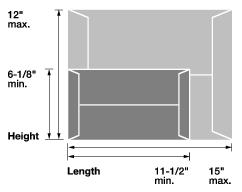|
|
|
|
|
|
| |
Quick Service Guide 201cCommercial FlatsPhysical Standards for Commercial FlatsMay 31, 2015 Overview
For physical standards of automation flats, see Quick Service Guide 201d. In addition to shape, the Postal Service classifies mailpieces by the way they are prepared. These classifications are based on how efficiently your mailpieces can be processed on Postal Service equipment. The Postal Service classifies commercial flats as either nonautomation or automation flats or machinable and nonmachinable for Periodicals. A flat meets automation standards and qualifies for automation prices if it meets the specific addressing, barcoding, and design standards. Automation flats must have a POSTNET or Intelligent Mail barcode with a delivery point routing code. Dimensions, Shape, Flexibility, and Uniform Thickness (201.4.0)
Shape: rectangular, with four square corners, or with finished corners that do not excced a radius of 0.125 inch (1/8 inch). Flexibility and deflection: flat-size pieces must meet flexibility criteria in 201.4.3 and the deflection criteria in 201.4.6. Flats mailed at saturation or high density prices or flats mailed at basic carrier route prices and dropshipped to DDUs do not have to meet deflection standards. All other flats not meeting deflection standards are subject to prices as stated in DMM 201.4.7. Uniform thickness: the contents must be uniformly thick so that any bumps, protrusions, or irregularities do not cause more than 1/4 inch variance in thickness (201.4.4). When determining variance in thickness, exclude the outer edges of a mailpiece (1 inch from each edge) when the contents do not extend to the edges. Mailpieces that do not meet the standards for flexibility in 201.4.3, for uniform thickness in 201.4.4, or for polywrap in 201.4.5, must pay applicable prices as follows: Presorted Nonautomation Flats (201.5.0) Automation Flats (201.6.0) Flats may qualify for the automation discount based on the physical standards in 201.6.0. See Quick Service Guide 201e, Designing Flats for Automated Processing, for an overview. Quick Service Guides 207f Barcoded (Automation) Flats
|
||||||||||||||||||||
